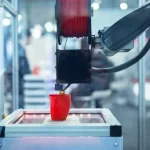The critical advantages of FDM over FFF are: the resolution of the build (better-looking and more accurate models), and the reduced risk of distortion and porosity that results from a haphazard temperature environment.
FDM vs. FFF: Technology Comparison
FDM machines are well built, rugged, and capable and require little maintenance. FFF machines, on the other hand, range from the basic, open frame types to professional devices that seem like ‘baby’ FDM machines. Both technologies use similar X-Y-Z rails and stepper motors. Stiffness, however, is a big factor in model resolution/quality. Heavier machines print better models because they’re more mechanically and thermally stable.
FDM vs. FFF: Material Comparison
FDM and FFF machines can both use a wide range of materials, including many that are great for mass production. FDM machines, however, have better control over nozzle temperatures. They can handle engineering polymers with higher melting points. They are also better with additives in the filament.
FDM vs. FFF: Product Applications Comparison
FFF makes porous, low-strength, low-resolution models. These are suited for shape-and-feel evaluation but not for operational or waterproof parts. The layers of FDM parts, on the other hand, fuse more completely and exceed FFF part strength. This makes FDM-printed parts better suited to engineering models.
FDM printers also accept a wider range of filament properties including melt temperature and additives. If used for prototyping, this means the models will more closely resemble finished products. FFF printers are not suited to fine-featured model builds. They simply cannot produce small features.
FDM vs. FFF: Print Volume Comparison
FDM systems are designed to meet professional standards; their greater costs are meant to be offset by the higher quality of their products. These machines are built with volumes ranging from 305 x 305 x 254 mm (X-Y-Z) up to 914 x 914 x 609 mm. This compares with typical FFF machines which run between 150 x 150 x 150 mm and 600 x 600 x 600 mm worth of build space. Most FFF machines are small but still struggle to produce models whose quality is consistent across the entire Z-axis range. FFF printers have relatively poor dimensional accuracy and their parts tend to warp.
FDM vs. FFF: Surface Finish Comparison
Of the two, FDM parts are generally built using finer filament feedstock and smaller Z steps, so their surface finish is more impressive. FFF stock is of larger diameter so the resulting parts are lower resolution and the layers do not fuse as well.
FDM vs. FFF: Cost Comparison
FDM machines are generally aimed at the professional market with prices ranging from around $2,500 up to $25,000 for advanced industrial grades. This reflects high build quality, stiff axes of motion, and the ability to print all day without problems. While FFF machines are beginning to filter into professional use, they are more often aimed toward light, hobby, and home use. Prices usually start at $500.
.webp)
